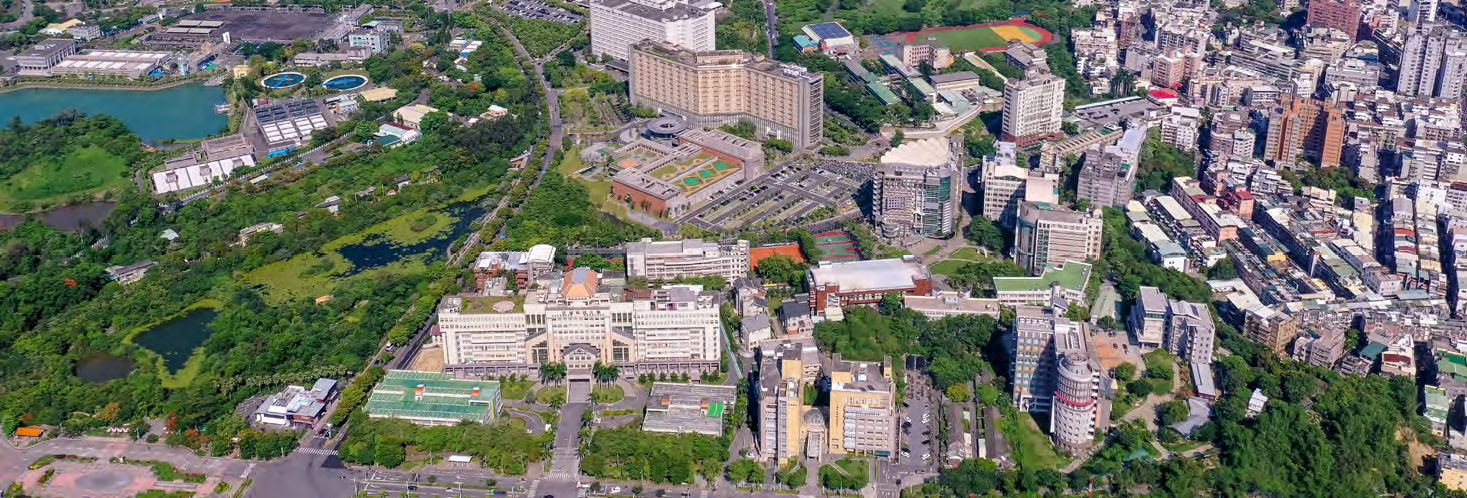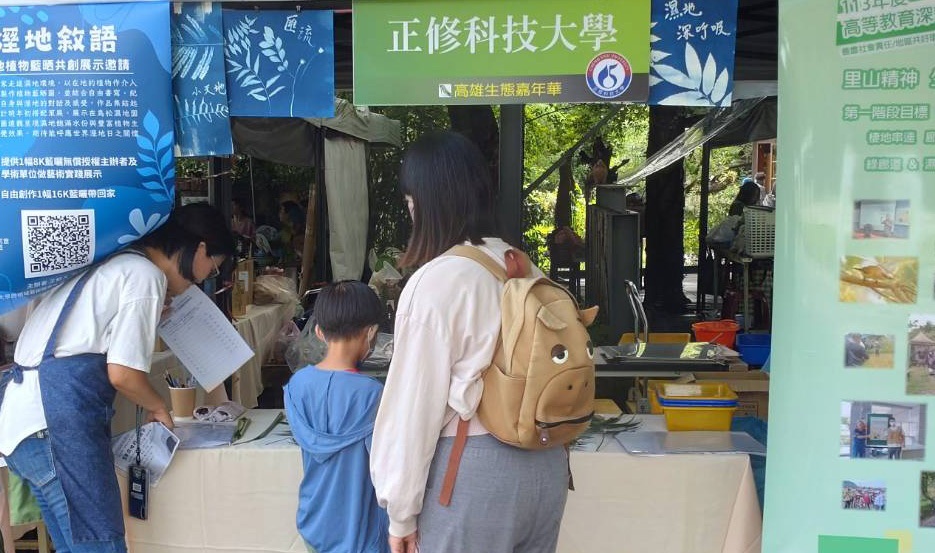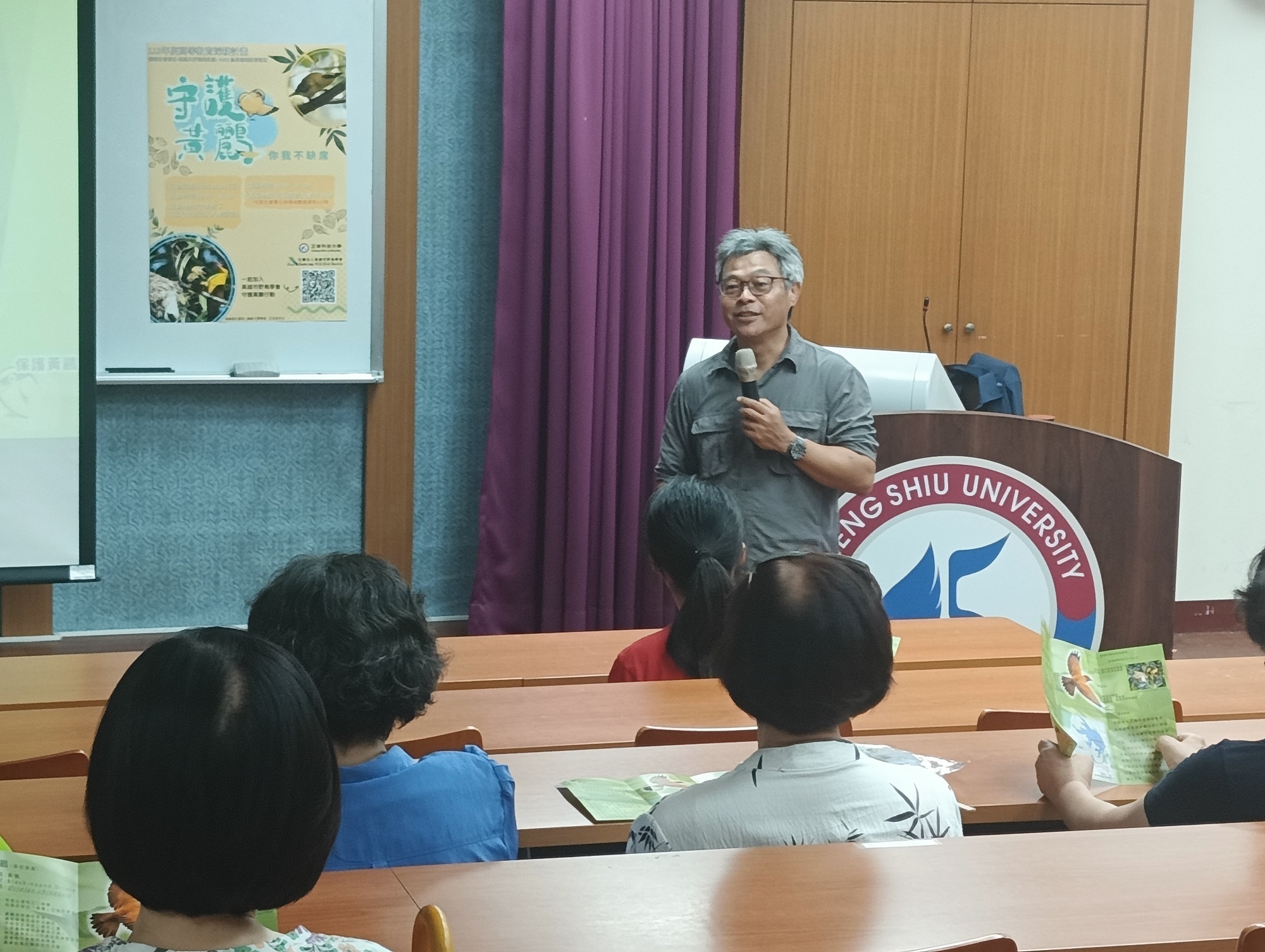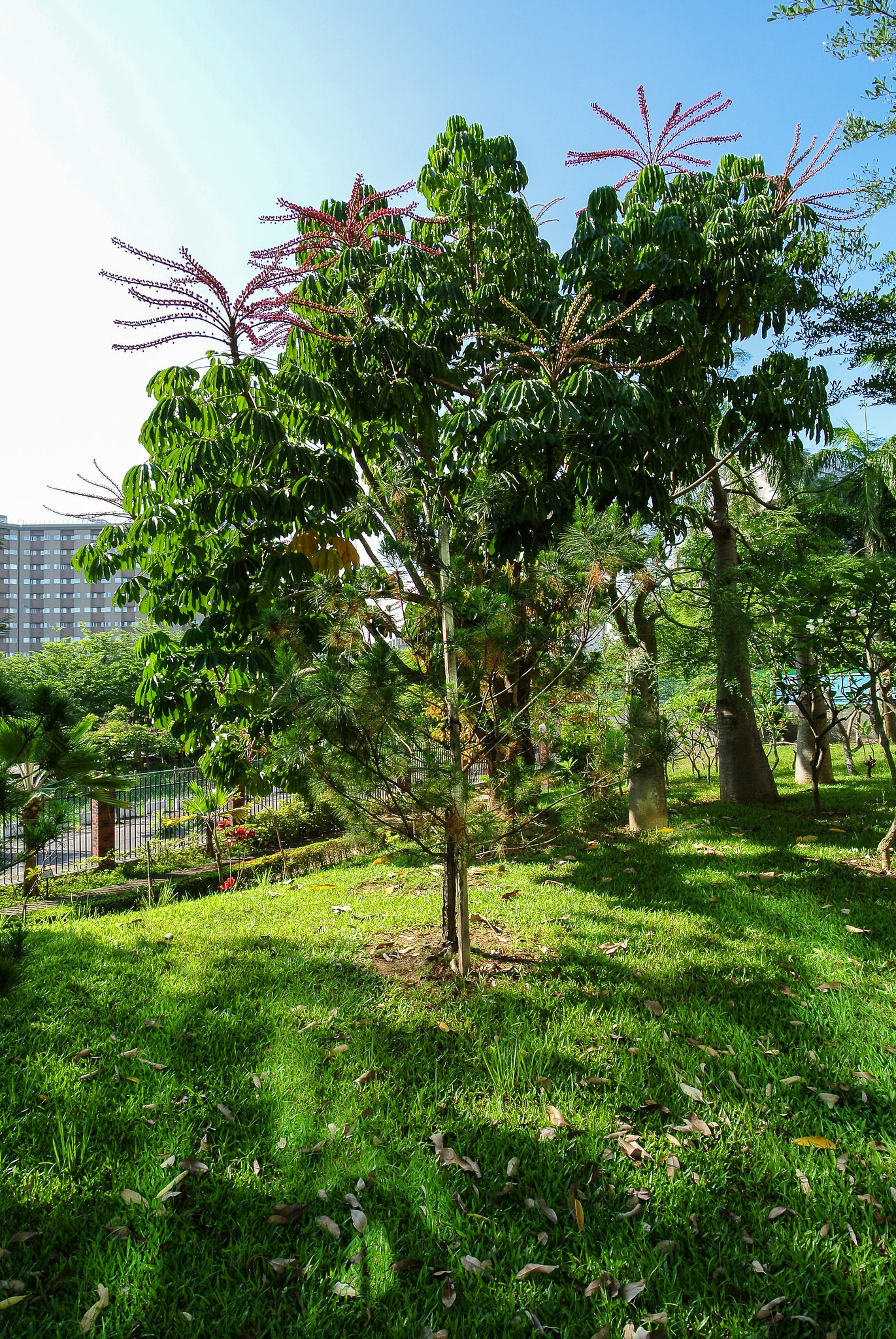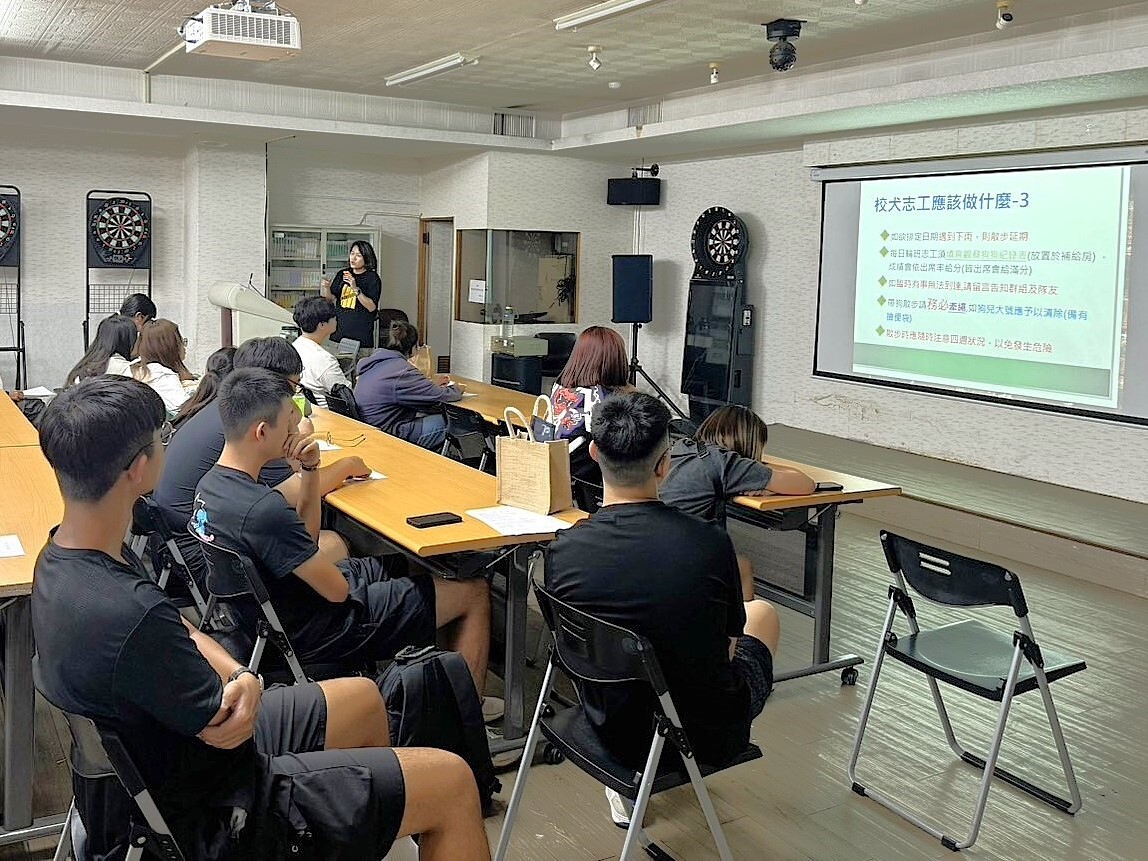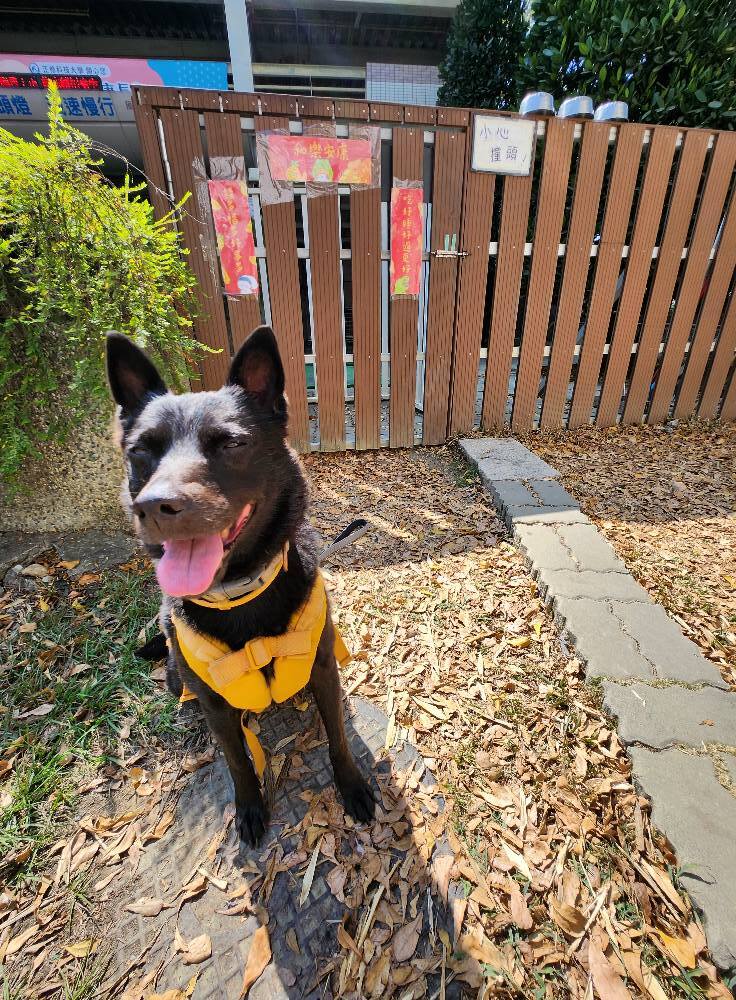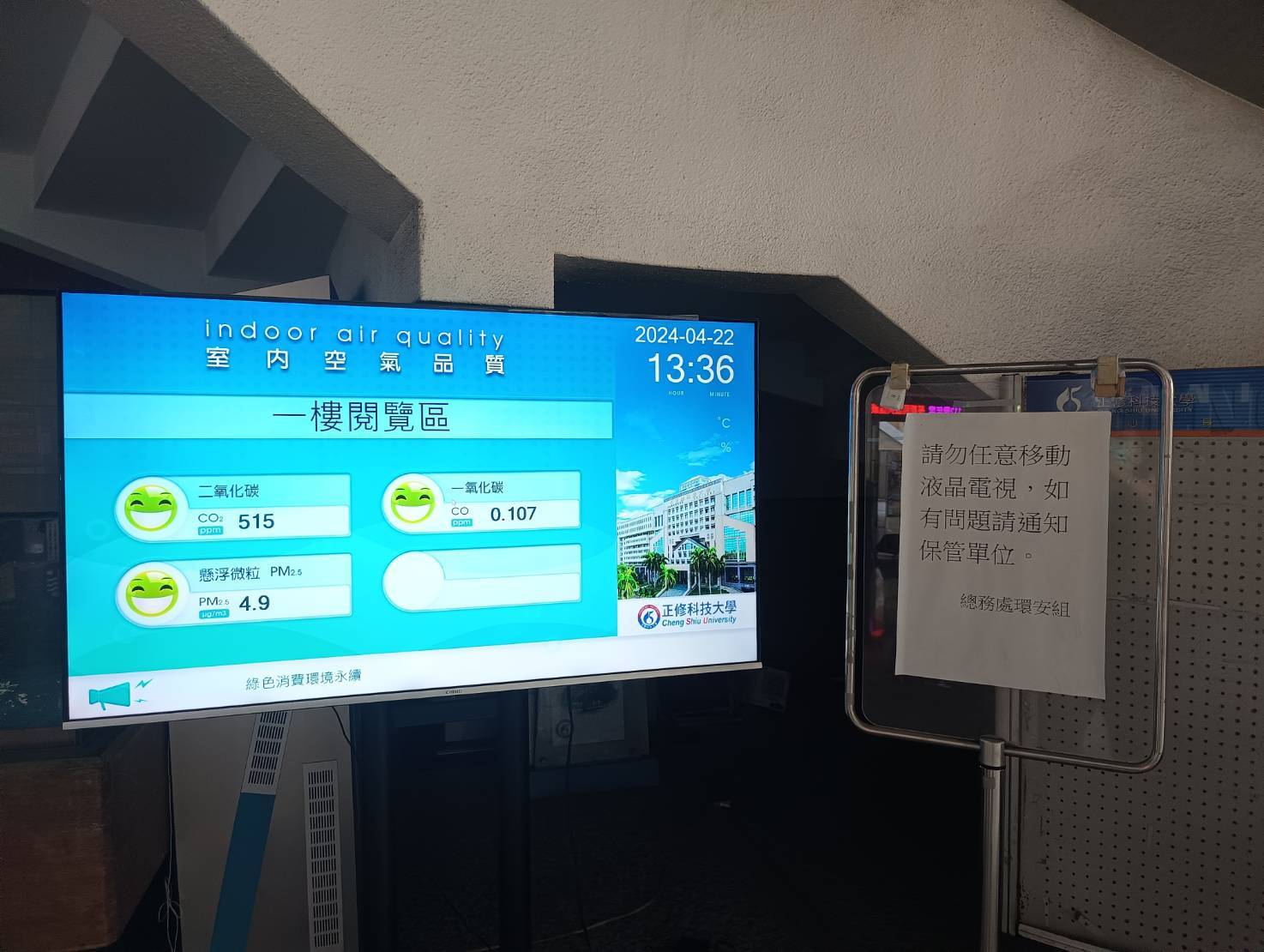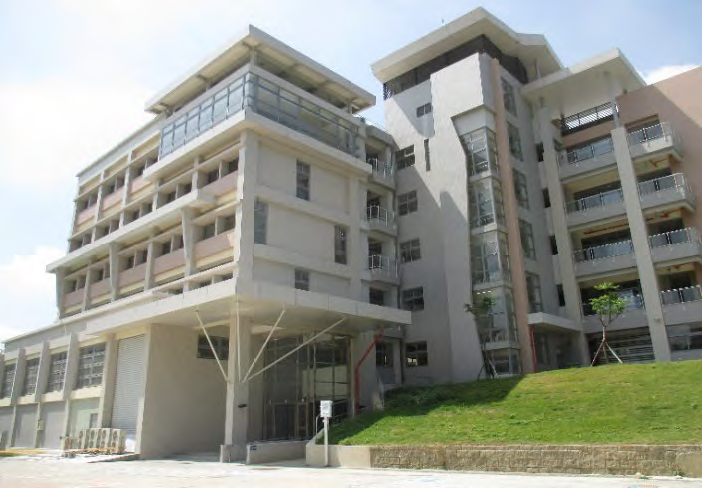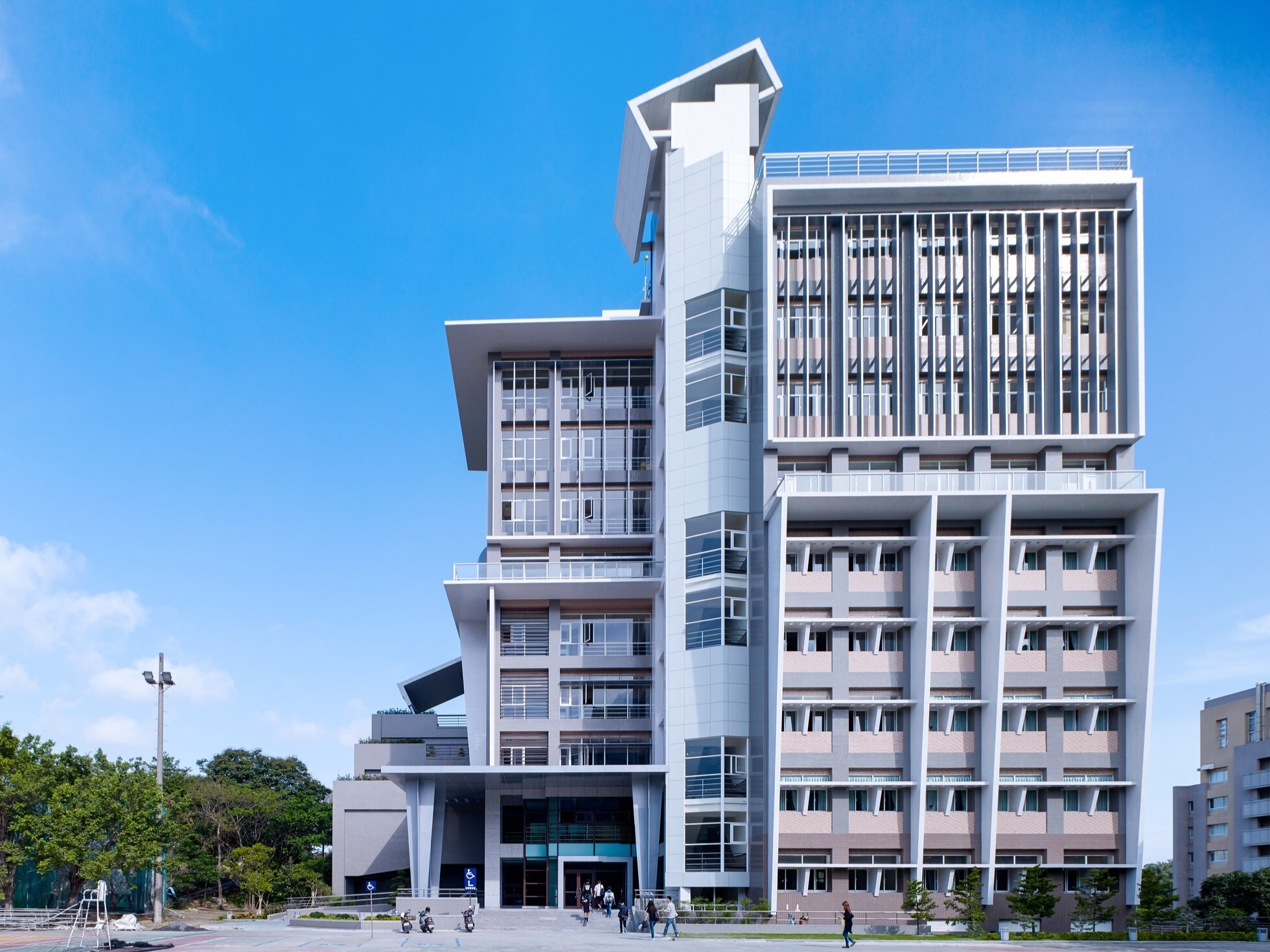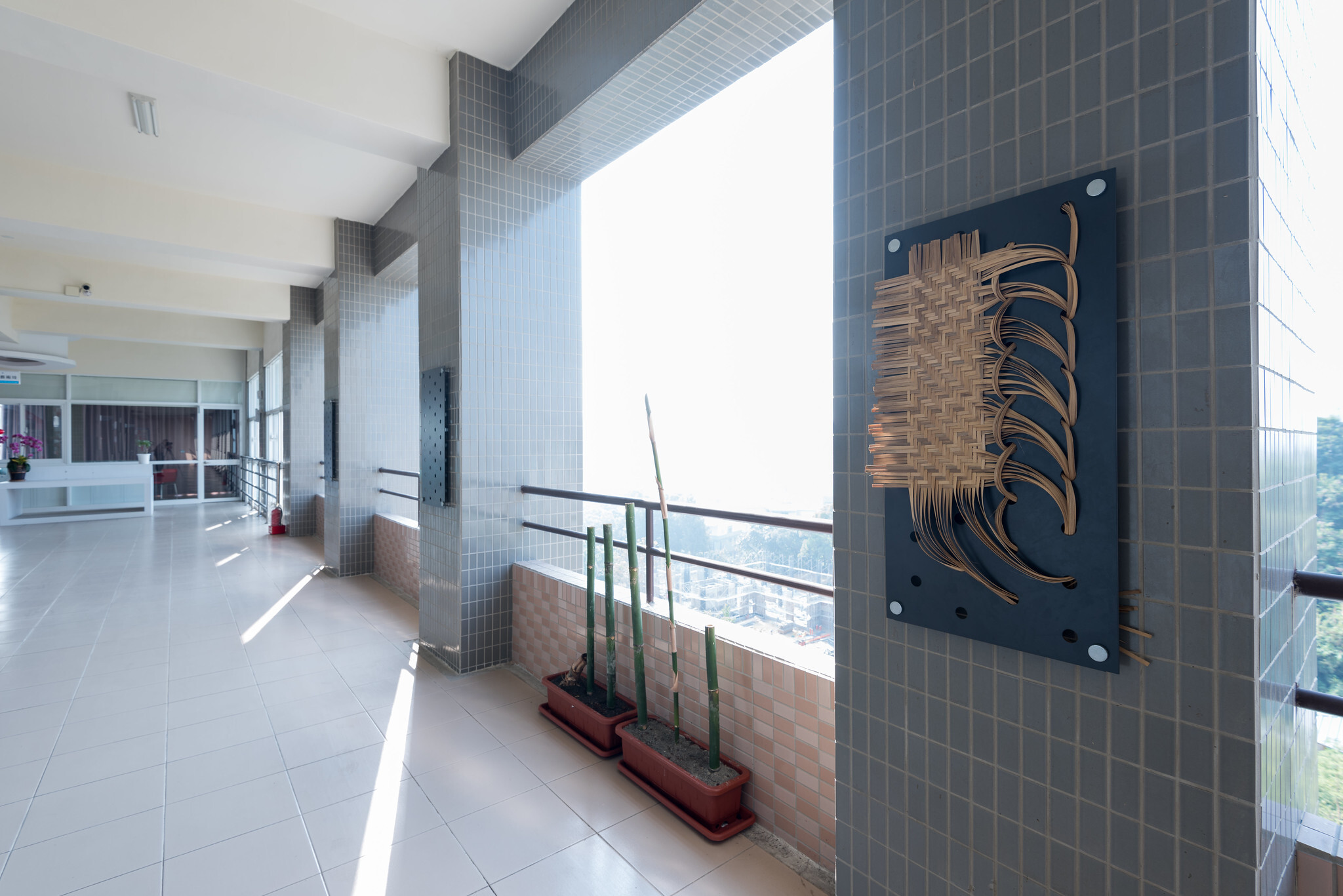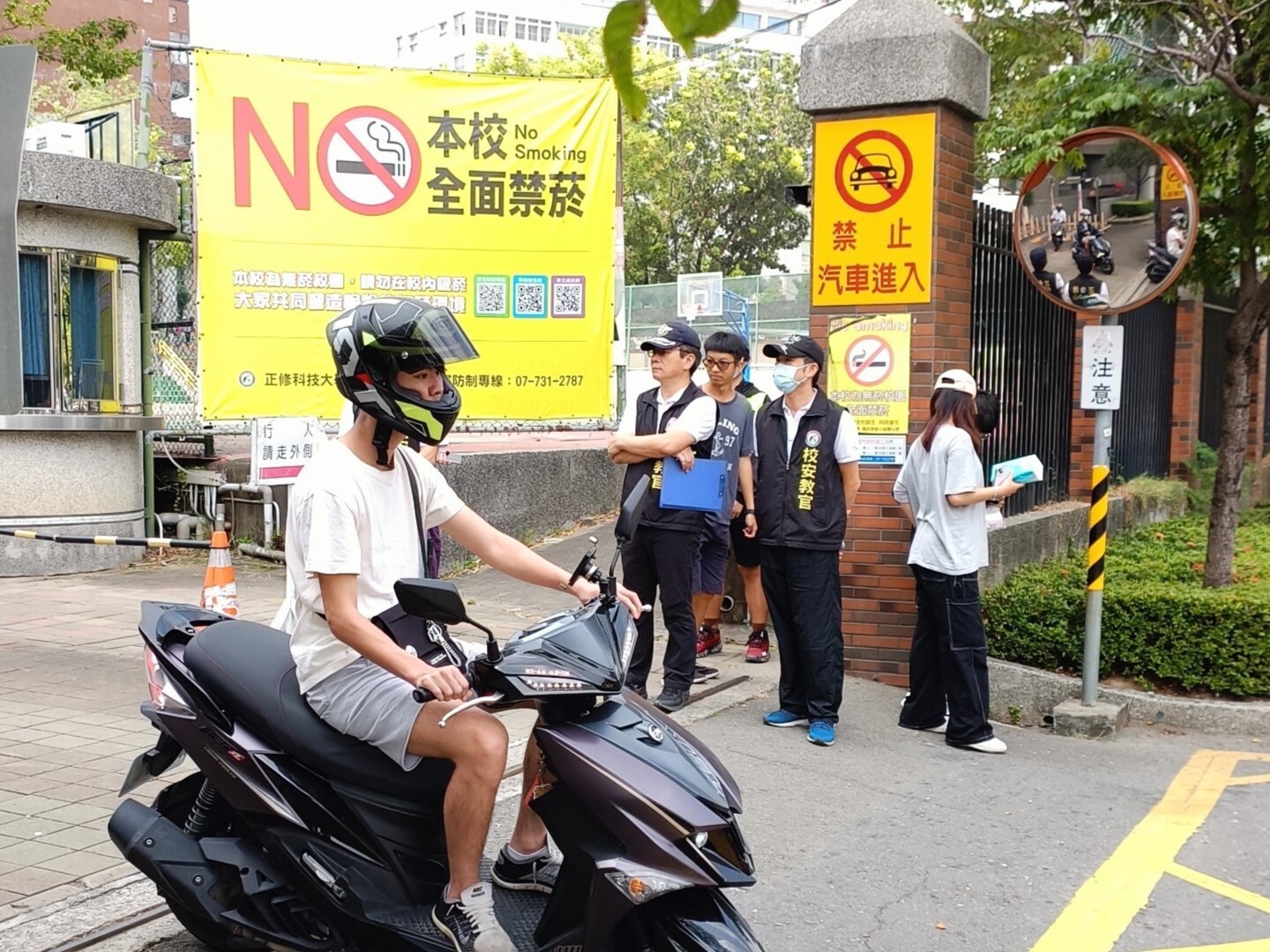Campus Ecology and Environmental Preservation
Cheng Shiu University covers an area of approximately 9.75 hectares, located near Chengcing Lake Scenic Area and Niaosong Wetland Park. The surrounding areas are planted with various native tree species of Taiwan, along with butterfly- and bird-attracting plants, creating a diverse ecological environment that provides both water sources and habitats for multiple bird species.
Campus Ecological Environment
Within the campus, a variety of trees and shrubs can be observed. Small lotus ponds and koi ponds provide freshwater habitats for dragonflies, damselflies, frogs, and other amphibious species, enriching biodiversity while offering students valuable opportunities to engage with nature.
|
▲ Aerial view of the campus - adjacent to Niaosong Wetland and Chengcing Lake |
Promoting ecological conservation of Niaosong Wetland
For many years, our school teacher Zhang Haoxian has collaborated with the Kaohsiung Wild Bird Society on the Kaohsiung Oriole Protection Campaign (a Class II rare and precious protected bird). Through ecological conservation education and plant maintenance and pruning, they help create a habitat for the orioles in Niaosong Wetland Park, enhancing the environmental conservation and ecological restoration of the Niaosong Wetland.
In 2023, Zhengxiu reached a collaboration agreement with the Kaohsiung Wild Bird Society and the Kaohsiung Shan Geng Agricultural Products Cooperative to promote the conservation and ecological restoration of the Niaosong Wetland by establishing habitat-connecting corridors, primarily using greenways and wetland corridors.
Our school's "Niaosong Environmental Education Implementation" action plan continues to collaborate with the Kaohsiung Wild Bird Society. Teachers and students work together to protect the oriole habitat, implementing local conservation actions through ecological surveys, monitoring, and environmental maintenance.
At the same time, we combine undergraduate students and senior class students to promote cross-generational learning, hold lectures on oriole ecological conservation, and provide in-depth understanding of its ecological habits and environmental needs. We also encourage citizens to participate in science and enhance ecological conservation awareness and social influence.
|
▲ Oriole found on campus |
▲Malayan Night Heron |
|
▲Joint Awareness Campaign with the Kaohsiung Wild Bird Society |
▲ Lecture on oriole conservation |
Campus Tree Species Survey
In late 2023, the University launched a campus tree survey, identifying diverse native species such as banyan, camphor, Taiwan golden-rain tree, Chinese pistache, and orange jasmine, along with common trees and ornamentals including blackboard tree, mahogany, royal palm, cacao, and osmanthus.
In 2024, Typhoon Sanba caused severe damage, toppling several trees across campus that required removal. Integrating post-disaster recovery with sustainability education, the University incorporated tree and ecological monitoring into related courses, guiding students to conduct on-site ecological surveys. Further plans include recording tree height, diameter at breast height (DBH), and volume to establish a campus tree database. This will serve as a reference for evaluating baseline carbon sequestration capacity and developing campus carbon-reduction strategies.
|
▲ Inflorescence and fruit pods of Aleb |
▲ Rest area shaded by Terminalia truncatula |
|
▲ Small lotus pond |
▲ Australian Schefflera |
Campus Guard Dogs and Volunteer Team
Originating as stray dogs that settled on campus, these animals came to regard Cheng Shiu as their “home,” often accompanying security staff on patrols. Although cautious around people, they have never displayed aggression. In 2013, with support from the Kaohsiung Animal Protection Office, the University joined the Friendly Campus Animal Program, adopting and managing stray dogs as approachable Campus Guard Dogs. This not only reduced the entry of outside strays but also lowered risks of chasing or attacks, thereby enhancing campus safety.
In 2014, the University established the Guard Dog Volunteer Team, recruiting students to organize awareness campaigns that highlight the importance of life education and foster a sense of territory for the dogs. By August 2024, with assistance from the Kaohsiung Animal Protection Office, all six campus dogs had been vaccinated against rabies and neutered.
Guard dogs are more alert during curfew hours. To avoid incidents, students and staff leaving campus late at night may contact the security office (ext. 1155) to request an escort.
|
▲ Campus Guardian Dog Volunteer Briefing |
▲ Campus Guardian Dog |
▲ Guardian Dog Volunteer Team |
Campus Greening and Landscaping
The campus environment is managed by the Office of General Affairs, which oversees routine maintenance such as pruning and irrigation to sustain landscape quality and ecological sustainability. According to the Kaohsiung City Urban Planning Act, universities are limited to a maximum building coverage of 40%. Cheng Shiu University maintains 39,000 m² of open space, with a 40% green coverage ratio and 40% permeable surface ratio, reflecting strong green planning and eco-friendly indicators.
In landscape and ecological management, preventive treatments and monitoring for brown root disease are conducted each spring and autumn to reduce the risk of tree collapse during typhoons. Regular monitoring and treatment of invasive species such as red imported fire ants further safeguard biodiversity and campus safety. During typhoon seasons in summer and autumn, the University proactively prunes and inspects large trees to minimize risks from extreme weather, ensuring environmental stability and disaster resilience. Through these daily management practices and early warning mechanisms, the University demonstrates its commitment to environmental sustainability and ecological protection.
Campus Green Area
|
Item |
Academic Year 2023 |
|
Total Campus Area (㎡) |
97,500 |
|
Total Green Coverage Area (㎡) |
27,213 |
|
Non-Green Permeable Area (㎡) |
41,159 |
|
Total Floor Area of Campus Buildings (㎡) |
215,168 |
|
Grass Coverage Area (㎡) |
8,164 |
|
Green Coverage Ratio (%) |
40% |
|
Permeable Surface Ratio (%) |
40% |
Notes 1: Carbon Sequestration Equivalent of Greening (tons CO₂e/year) = Planting Area (㎡) × Plant Carbon Sequestration Coefficient ÷ 1000.
Notes 2: Formula for Campus Green Coverage Ratio: Green Coverage Ratio = (Tree Canopy Area + Grass Coverage Area) ÷ (Total Campus Area − Licensed Building Footprint) × 100%. Trees with DBH ≥ 20 cm are calculated with a 10 m canopy diameter. Trees with DBH < 20 cm are calculated with a 5 m canopy diameter. Grass and tree canopy areas are not double-counted.
Notes 3:Formula for Campus Permeable Surface Ratio: Permeable Surface Ratio = Permeable Area ÷ Total Campus Area × 100%. Permeable areas include interlocking bricks, lawns, exposed soil, clay tiles, and tree growth zones, excluding building footprints and basketball courts. 1 hectare = 10,000 m².
Campus Air Quality
According to the Environmental Protection Administration’s zoning of air pollution control areas, Cheng Shiu University is located in a Level 3 control zone for suspended particulates (PM10), fine particulates (PM2.5), and 8-hour ozone concentration (O3-8hr), and in a Level 2 control zone for hourly ozone (O3-HR), sulfur dioxide (SO2), nitrogen dioxide (NO2), and carbon monoxide (CO).
To safeguard the health of students and staff and ensure good air quality on and around campus, the Environmental Safety Section conducts indoor air quality monitoring and biannual reporting every June and December. The University Library is equipped with an Indoor Environmental Management System. Sensors on each floor activate the ventilation system when indoor CO₂ concentration reaches 950 ppm, balancing air quality with energy efficiency.
A certified Indoor Air Quality Manager is designated to oversee compliance, routine testing, and online reporting. From 2020 to 2024, all monitoring results met regulatory standards. In 2024, the University was awarded the Excellent Grade Indoor Air Quality Self-Management Label.
|
▲Indoor Air Quality Monitoring System |
▲Indoor Air Quality Monitoring System |
|
▲ Excellent Grade Indoor Air Quality Self-Management Label. |
2024 Campus Air Quality Monitoring Results
|
Monitoring Item |
Campus Air Quality Monitoring Results |
|
|
First Test 2024/6/26 |
Second Test 2024/12/25 |
|
|
CO-8hr(ppm) |
0.2 |
0.4 |
|
SO2(ppm) |
0.002 |
0.002 |
|
NO2(ppm) |
0.01 |
0.021 |
|
O3-8hr(ppm) |
0.028 |
0.015 |
|
PM10(μg/m3) |
19 |
49 |
|
PM2.5(μg/m3) |
8 |
36 |
Use of Green Building Materials
In compliance with the Green Building Label Standards, the University incorporates ten key aspects: biodiversity, greenery preservation, site water retention, daily energy efficiency, carbon reduction, waste reduction, indoor and outdoor environmental quality, water conservation, wastewater and waste management, and dedicated waste collection facilities. All new campus buildings adopt materials that meet green building requirements and are designed with green architecture elements.
|
▲ Industrial Park Building, building exterior |
Our school's "Life Creativity Building" was completed in 2014. It incorporates green building design and barrier-free facilities. The building's window sills are all made of transparent tempered glass, and the corridor railings are also designed with semi-transparent railings. This is not only safe, but also allows people with limited mobility in wheelchairs to have an unobstructed view, creating a friendly campus environment. It has won the "Kaohsiung City Barrier-Free Friendly Environment Selection Excellence Award."
|
▲ Friendly Architecture-Life Creative Building, building exterior |
▲ Friendly Architecture - Life Creative Building, the corridor uses semi-transparent railings |
▲ Friendly Architecture - Creative Living Building, Sky Platform Garden |
Promotion of a Smoke-Free Campus
Since September 1, 2016, Cheng Shiu University has enforced a smoke-free campus policy. The regulations are outlined in the University’s Tobacco Hazard Prevention and Smoke-Free Campus Guidelines.
A Smoke-Free Campus Promotion Committee, chaired by the President and including representatives from key administrative offices, oversees effective implementation of tobacco control on campus.
|
▲Comprehensive Promotion of a Smoke-Free Campus |
▲Smoke-Free Walkway at the Side Entrance |
|
▲Community Health Fair – Hazards of Tobacco and Drugs |
▲Tobacco Control Awareness Seminar |

